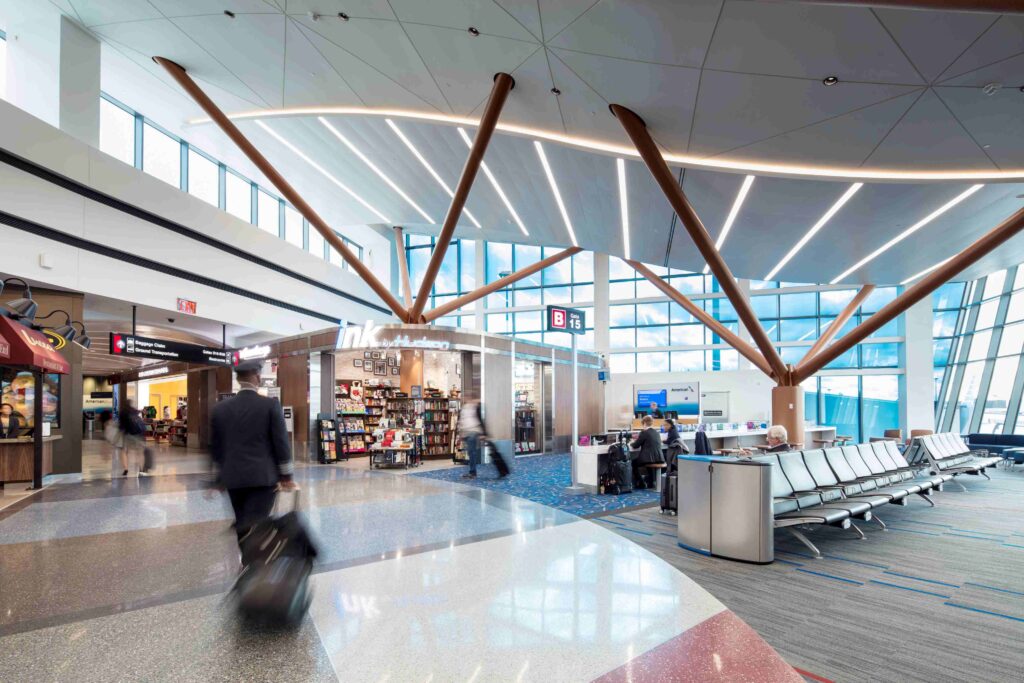Continuous operations: Designing to keep people flying during airport terminal construction
It takes a village to run an airport, an even bigger village to construct at one, and a team of professionals to bring it all together. Communication, phasing and an emphasis on passenger experience are key to delivering airport terminal expansion and renovation projects that advance smoothly even as the airport continues its vital around the clock operations.
Airports in the United States generate more than $1.4 trillion in annual economic activity and support nearly 11.5 million jobs. With air traffic expected to more than double in the next 20 years and the average U.S. airport almost four decades old, expansions and renovations are operational and economic necessities.

Massport’s Terminal B Optimization Project. Our work on the Logan International Airport’s Terminal B Optimization Project in Boston, undertaken for Massport, demonstrates the key roles that communication, phasing and an emphasis on the passenger experience play in advancing terminal construction. Embracing these three principles as we maintained around the clock airport and tenant operations, enabled AECOM to deliver the project ahead of schedule while ensuring safety and comfort for builders and the public. In short, Terminal B is the epitome of continuous operations done right.
The completed project accommodated American Airlines’ consolidation onto a single pier and incorporated renovations to 125,000-square-feet of the existing Terminal B and a 60,000-square-foot terminal expansion. Work entailed consolidating three security checkpoints into one modern checkpoint, extensive holdroom renovations and airside site fueling modifications at 21 active gates, replacing the terminal’s sewer system, new concession spaces and a new outbound bag room. As the prime architect and engineer, AECOM served as the designer and architect of record, provided project management, interior design, airside planning, civil engineering, security engineering and construction administration services.
Communication. Airports encompass a vast community of people who are impacted by and will have an impact on potential changes. Early stakeholder engagement at the outset of a project — whether through formal or informal meetings — is particularly important. It is the first step in making the airport community aware of upcoming change and creating opportunities for input at a point where changes can be easily implemented. It also sets the stage for regular, structured communication throughout the project ensuring that all are informed and able to act on upcoming changes.
On the Terminal B project, we developed a stakeholder engagement plan around upcoming terminal gate number changes through a sequence of closures and eventual “overnight” change. Addressing the timing, frequency and contact type for each impacted stakeholder, the plan informed all involved of operational changes. This enabled issues to be identified and managed well in advance and the gate renumbering to come off without a hitch.
Phasing. Maintaining airport operations throughout construction is a paramount concern. We use phasing to accomplish this. While a contractor partner is key to validating and implementing construction phasing, designers can also help facilitate project phasing.
The Terminal B project improved existing gate configuration and capacity by upgauging each aircraft parking position forcing associated aircraft fueling line and pit relocations, new apron paving and new aircraft parking positions. And, importantly, we improved passenger comfort by adding new furniture and finishes to all departure lounges.
To accomplish this work while maintaining airline operations, we used a flexible, phased coordination plan that choreographed the interior renovation and exterior modifications to happen simultaneously. The alignment of the schedule between this interior and exterior work on a gate-by-gate basis enabled the team to maximize usable gates for the airlines throughout construction.
Passenger Experience. Enhancing the passenger experience is a priority for a completed terminal improvement project. Ensuring positive passenger experiences during the extended airport construction time is also important. After all, a happy passenger is more willing to spend time — and money — in an airport terminal.
Elevating the passenger experience during construction is challenging, but practical cost-effective measures such as minimizing hard turns, maximizing visibility to the next destination, and making wayfinding elements consistent with the rest of the airport can go a long way to making this a reality.
At Terminal B, close coordination between our designers, the contractor, and terminal managers enabled the project team to focus on passenger wayfinding. We deployed continuous, phased wayfinding graphics communicating upcoming gate closures and gate numbering changes to passengers that enabled them to easily move to their destinations despite the terminal’s everchanging construction landscape. With air travel expected to more than double over the next two decades and the potential for new investment in airport construction, maintaining continuous operations while prioritizing and elevating passenger comfort and convenience will become even more important across the aviation industry. Terminal B exemplifies continuous operation done right and will provide passengers and airlines the services they need for decades to come.






